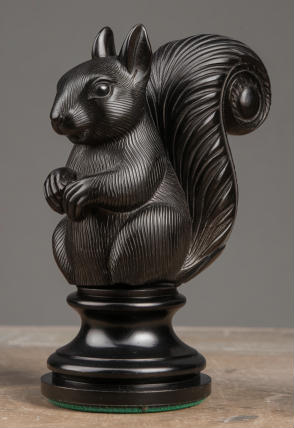Piececlopedia: Squirrel
Historical notes

In A Guide to Fairy Chess, Anthony Dickins attributes the invention of this piece to N. Kovacs. In 1937, Kovacs published a problem with a Squirrel in Fairy Chess Review. Although we may presumably attribute the present name of Squirrel to Kovacs, the earliest known use of this piece is a few centuries earlier. In 1683, Dr. Francesco Piacenza published rules for a game called Arciscacchiere (Arch Chess), in which this same piece was called a Centurion.
This piece is called a Castle in two games reported by John Mantle Green: Pacific Chess, which he found people playing in Hawaii, and the related game Mideast Chess, which he found people playing in California. The name of Castle comes from Edward Falkener's book Games Ancient and Oriental and How to Play them, and it is not known what name Green actually knew the piece by.
In Moeser's Neue Chess, one can read about a chess variant where Squirrels replace the Queens.
The piece is called a Bear in the eponymous game Bear Chess, once popular in the USSR.
Movement
The Squirrel has the combined moves of Dabbabah, Alfil, and Knight, i.e., it can move two squares in any direction (orthogonally or diagonally) or like a knight, one in one orthogonal direction and two in the other orthogonal direction.
When moving, the Squirrel can jump, i.e., it can complete the move, regardless of whether the squares passed over are occupied or not.
Movement diagram
![]()
![]()
![]()
![]()
![]()
![]()
![]()
![]()
![]()
![]()
![]()
![]()
![]()
![]()
![]()
![]()
![]()
![]()
![]()
![]()
![]()
![]()
![]()
![]()
![]()
![]()
![]()
![]()
![]()
![]()
![]()
![]()
![]()
![]()
![]()
![]()
![]()
![]()
![]()
![]()
![]()
![]()
![]()
![]()
![]()
![]()
![]()
![]()
![]()
![]()
![]()
![]()
![]()
![]()
![]()
![]()
![]()
![]()
![]()
![]()
![]()
![]()
![]()
![]()
The Squirrel (here depicted with a rotated Queen - this may not be a known convention) can move to any square with a black circle, regardless of whether squares it passes over are occupied or not.
Notes
This piece can generally force checkmate against a bare king, with the help of its friendly king. Try it!Vocabulary: Perimeter
A perimeter of a particular space is the ring of spaces that are all the same distance from it. Each perimeter is numbered by its distance from a central space. So, the first perimeter consists of every space diagonally or orthogonally adjacent to a central space. For example, a King is normally able to move to any space in its first perimeter, and except for castling, its move never takes it beyond its first perimeter. The second perimeter of a space is the ring of spaces two spaces away. These are the spaces that can be reached by moving twice in the same direction or by moving as a Knight. The Squirrel is able to jump to any space in its second perimiter. There are also third, fourth, and fifth perimeters and so on. The only limitation on how many permiters a space may have is the size of the board.
Alternate Images
Click on an image to view the full piece set it belongs to.
 |
References
Dickens, Anthony. A Guide to Fairy Chess. Dover Publications: New York, 1969, 1971.
Jellis, G. Notes on Generalized Chess, Variant Chess vol. 1, issue 1, p. 8-9, 1990.
This is an item in the Piececlopedia: an overview of different (fairy) chess pieces.
Written by Hans Bodlaender and Fergus Duniho. AI image added by Fergus Duniho.
WWW page created: May 30, 1999. Last modified: November 21, 2024.